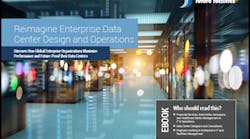Roundtable: Where North American Data Center Supply Chain Challenges Meet Creative Industry Alliances
A recent DCF 'Voices of the Industry' editorial by Robert Moffitt, President of Blueprint Supply Chain, pointed out how for data center developers: "The truth is that demand has long outpaced supply, and the data center market is still trying to catch up."
Moffitt added, "Those in charge of these projects are desperately seeking to collect a stable of national and regional contractors, suppliers, and partners that can help navigate the many challenges that affect speed to market, service delivery, and ultimately, profitability."
For the final installment of our Executive Roundtable for the First Quarter of 2024, we ask for our five seasoned industry experts' takes on to what degree they see larger projects and heightened demand exacerbating challenges with North American supply chains and delivery timelines for data centers in 2024.
We also asked: To what degree do you see creative partnerships and strategic mergers and acquisitions potentially helping to alleviate such obstacles?
Our distinguished panel of leaders for the First Quarter of 2024 includes:
Sean Farney, VP of Data Center Strategy for the Americas, JLL
Ian Golter, Engineered Solutions Manager - Datacenters, Kohler Co.
Brandon Peterson, Senior VP of Business Development, CoolIT Systems
Stuart Lawrence, VP, Product Innovation & Sustainability, Stream Data Centers
Eric Schwartz, CEO, CyrusOne
Now let's find out our industry leaders' responses to the final question of our Executive Roundtable for the First Quarter of 2024.
Data Center Frontier: To what degree do you see larger projects and heightened demand exacerbating challenges with North American supply chains and delivery timelines for data centers in 2024, and to what degree do you see creative partnerships, mergers, and acquisitions potentially helping to alleviate such obstacles?
Sean Farney, JLL: Collaboration is essential to delivering new data center projects in today’s environment, where the combination of highly constrained digital infrastructure, voracious demand and a long backlog of large capital items has created an extended supply/demand imbalance.
For example, JLL recently partnered with Schneider Electric and Lumen Technologies on a modular solution to deploy scalable, sustainable and on-net facilities at thousands of existing sites. The partnership leverages each player’s strengths — JLL's in real estate, Schneider's in design/build and Lumen's in connectivity — so the team can deliver projects in months instead of years, creating value greater than the sum of the parts.
I'd even venture to say that we are moving into a period when coopetition (strategic alliances between competing companies) will be what defines the most successful players.
Ian Golter, Kohler, Co.: The data center industry is experiencing tremendous growth with no sign of slowing down, and there’s no doubt that supplying materials to new builds has been and will continue to be one of the primary factors impacting the scope and speed of this growth.
At Kohler, we face a different challenge. We must ensure that we can source and manufacture enough products to keep pace with the immense standby power needs of new data centers coming online.
To meet this challenge, we’ve taken steps to strengthen our supply base where possible, through exclusive partnerships to guarantee our supply of specialty components and by broadening our vendor network for non-specialty components.
While creative partnerships, mergers, and acquisitions can help alleviate some supply chain obstacles, many constraints lie deep in multiple levels of the supply chain. Organizations that support data centers must continue constantly monitoring supply chain dynamics.
Forecasting, investing in resilience, designing for component flexibility, and adopting agile sourcing strategies can help navigate supply uncertainties.
Brandon Peterson, CoolIT Systems: There’s a major focus right now on AI, much of which requires liquid-cooling. This has driven a surge in demand for liquid-cooling technology in 2024 and into 2025.
While this is likely to continue, the growing CPU heat loads and rack densities in enterprise applications is another underlying trend that hasn’t yet had the visibility of AI.
Many enterprise data centers have not yet been forced into liquid-cooling the way AI data centers have, but we’re not far off that mark.
When CPU heat loads start to exceed 400W and rack densities start to exceed 30kW, liquid-cooling becomes substantially beneficial for performance and efficiency, in addition to simply keeping the CPUs below required temperatures.
As the enterprise market’s heat loads and rack densities continue to rise, a much larger portion of legacy air-cooled data centers will transition to liquid cooling.
Companies investing in supply chain via partnerships and other activities that strengthen and localize supply chains will be well positioned to serve this rapidly growing demand.
Stuart Lawrence, Stream Data Centers: Supporting hyperscale leasing requires a robust multi-year supply chain program. Yes, the scale of the challenge has grown exponentially.
Five years ago, an annual vendor-managed inventory program of 50-100 MW would have been considered satisfactory. Today, that number is north of 200 MW annually.
The providers that have a sophisticated supply chain process in place will be better positioned to cope with the increased demand, since those manufacturers are already in constant communication, have visibility into the pipeline and have been working on production related efficiency measures for some time.
In addition to inventory management, given the different customer technical requirements and need to deliver at scale and with speed, product architecture and component selection become paramount.
The ability to configure a product to meet the different technical needs, without heavy engineering and product redesigns, and more importantly without impact to cost and schedule is a major differentiator.
For some time we have seen several creative vendors partnering with other suppliers (some even old rivals) to deliver more flexible and scalable sub-assemblies that allow for more of a late point configuration on site.
In addition, with skilled labor causing upward pricing pressure, many developers are wise to partner with off-site fabricators where work can be completed in a more consistent and safe way.
Eric Schwartz, CyrusOne: Managing supply chain is an integral component of our business and challenges with long lead-time items persist for data center providers as well as for the broader power industry.
We continue to work closely with our suppliers as well as with utility providers to be responsive to our end-customers’ growth requirements and to use our overall scale to effectively allocate equipment across multiple locations.
Creative solutions are being deployed constantly to deal with challenges and that is likely to take many forms including alliances and partnerships.
Next: Data Center Frontier Q1 Executive Roundtable Recap
About the Author
Matt Vincent
A B2B technology journalist and editor with more than two decades of experience, Matt Vincent is Editor in Chief of Data Center Frontier.












